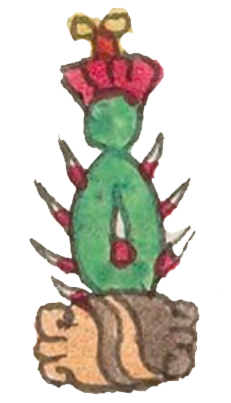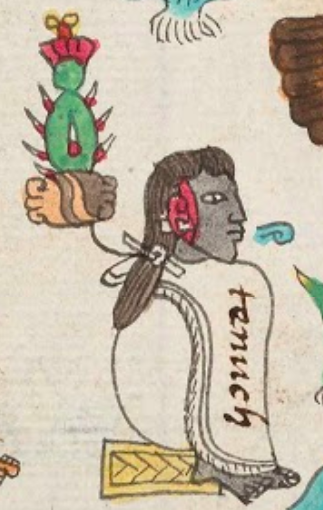Tenoch (Mdz2r)
This compound glyph stands for the personal name Tenoch (short for tenochtli, nopal or prickly pear cactus). The glyph is comprised of two principal elements, a stone (tetl) and a portion of a prickly pear cactus with a flowering fruit (nochtli) on top. The stone, a phonetic indicator, has the usual horizontal shape with curly ends and alternating purple and terracotta-colored stripes. The cactus is green, spiny, vertical, and has a green, red, and yellow flowering fruit on top. The spine or thorns are red with white tips. This is the usual compound glyph for the name of Tenochtitlan, the capital city, but also the glyph for the name of the legendary founder and ruler, Tenoch.
Stephanie Wood
See the contextualizing image for a portrait of the man of this name. He sits in a profile pose looking to the viewer's right. He wears a cape and sits on a small petate that elevates him somewhat from the ground. His hair is tied in a ponytail called a tzontli. Turquoise-colored speech scrolls emerge from his mouth.
The red and white spines on the cactus may have had an association with bloodletting (self-sacrifice), given that other sharp instruments also had this color combination. See below, right, for some additional examples, such as the tecpatl. The huitztli has a turquoise blue and red combination. The cactus fruit, when red, has a juice reminiscent of blood and a shape reminiscent of a heart. Blood-letting was a common method of auto-sacrifice, which may provide a religious significance to the personal name and the place name of the empire's capital city.
Stephanie Wood
tenuch
Tenoch
Stephanie Wood
by 1553 at the latest
Stephanie Wood
cactos, nopales, tunas, piedras, rocas, nombres de lugares

tenoch(tli), a nopal or prickly pear cactus, https://nahuatl.wired-humanities.org/content/tenochtli
te(tl), stone, https://nahuatl.wired-humanities.org/content/tetl
noch(tli), prickly pear cactus fruit, https://nahuatl.wired-humanities.org/content/nochtli
Codex Mendoza, folio 2 recto, https://codicemendoza.inah.gob.mx/inicio.php?lang=english
Original manuscript is held by the Bodleian Libraries, University of Oxford, MS. Arch. Selden. A. 1; used here with the UK Creative Commons, “Attribution-NonCommercial-ShareAlike 3.0 License” (CC-BY-NC-SA 3.0)












